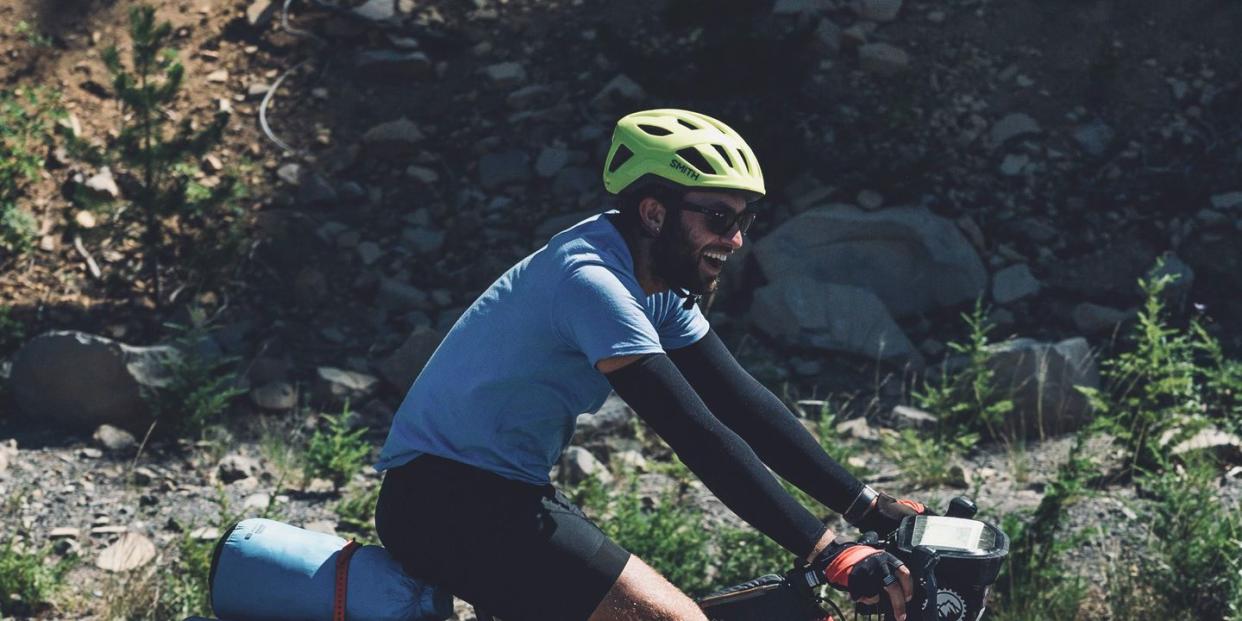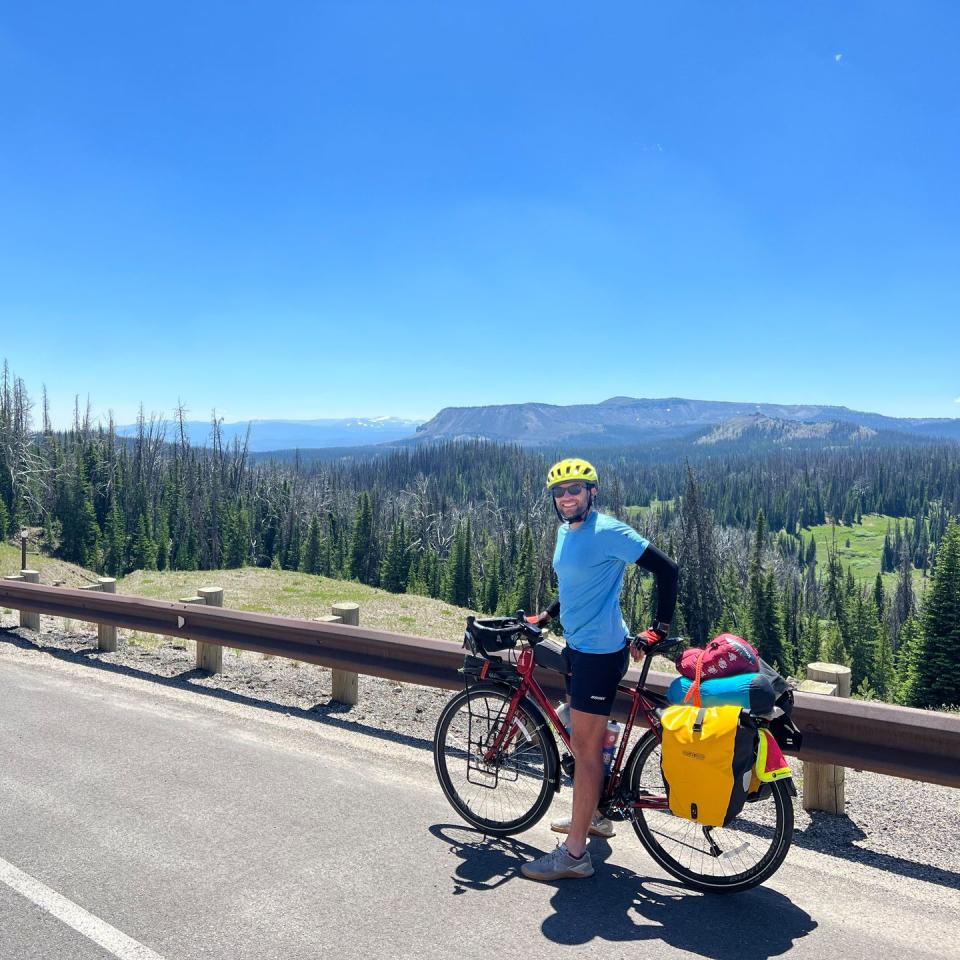This Cyclist Quit His Job to Ride More Than 4,000 Miles Across America

"Hearst Magazines and Yahoo may earn commission or revenue on some items through the links below."
Name: Ali Dastagirzada
Age: 27
Hometown: Philadelphia (Originally from Media, Pennsylvania)
Occupation: Currently in-between jobs, previously civil engineer
Time Riding: Since early childhood
Reason for Riding: I ride to challenge myself, to get out of my comfort zone, and ultimately, to travel across America.
I learned about the Trans America Trail in college from a friend who had done it back in 2015. He was a year below me and at one point, he took a semester off to do this cross-country tour of more than 4,000 miles. I followed him on social media and was shocked, thinking, “You can just ride your bike across the country?” He does photography, too, so he was taking these incredible photos. His journey stuck with me—though I didn’t have an actual plan to do the same until recently.
I’ve always ridden bikes leisurely, never competitively. I learned to ride when I was 3 years old. Growing up, we would ride bikes around the neighborhood with friends. We’d ride to a local Wendy’s without telling our parents, even though it was maybe half a mile up the road. It was fun. I always owned a bike.
I started to play with the idea to do the tour a few weeks into 2022. At the time, I worked as a civil engineer in traffic operations and transportation planning. I loved my company, and my coworkers were great, but the work itself wasn’t what I saw myself doing for the foreseeable future. I needed a break. I had money saved up and this idea in my head: I wanted a physical challenge that would get me out of my comfort zone.
My bike at the time wasn’t touring-specific, so to do this, I first needed a different bike. I was interested in either the Kona Sutra or the Trek 520. I was checking local stores online for weeks with no luck. Then, around mid-March, I saw this bicycle store in Baltimore actually had the Trek 520 in stock. I called and asked if they’d hold it for me, and I took the hour-and-a-half trip to Baltimore. They let me test ride it for about five miles—it was a great bike and I bought it. On my drive back home, my mind was racing: I could actually do this!
By May, I put in my two-weeks notice. My family didn’t believe I was serious at first, but when I told them I am committed to this trip, they were supportive. My mom and aunt drove me to Yorktown, Virginia, where the official starting point is and where, on Friday, June 3, I began my journey. I could have started anywhere, but I really wanted to do it properly.
I didn’t specifically train for this tour. I do go to the gym three or four times a week, so I thought I was physically fit, but I quickly realized I wasn’t in biking shape. I wanted to quit after the first day—I was that anxious. For one, my bike’s derailleur was giving me some problems, but that could be fixed. What was worse, I was ambitious and hoped to make it 40 miles, maybe 60 miles, that first day, and I had only gotten about 25 miles in before my body gave up. The worse was that my legs cramped up.
There was a campground where I first stopped, but it was full. I didn’t know what the hell to do. I couldn’t possibly ride 15 miles to the next one. By chance, I met a guy who offered to share his camp site. That’s when I first realized that there are people willing to help. I broke down crying, thinking how are people so nice? I sucked up my pride, put my ego aside, and accepted his help. The next day, I was supposed to ride 50 miles to Richmond, so I gave it a shot. It kicked my butt, but 50 miles later, I made it.
From there on, I tried to plan my stays two to three days in advance. I’d often call in advance to ensure availability—sometimes the next stop wasn’t for another 70 miles. Because the Trans America Trail is pretty well-known, there are a lot of churches, fire departments, and various organizations that host cyclists. I carried a list of possible places to stay. After some very hot and long days, I’d treat myself to a hotel, sometimes splitting the cost with another rider I met. And once I got more out west, I was able to do more camping.
The Adventure Cycling Association has maps specifically for the Trans America Trail, with elevation charts that I brought with me. I also had a digital file, but I didn’t like to follow it as much.
Most of the trail runs on low-volume roads, while other parts run on bike or pedestrian trails. There were some higher-volume state routes: I actually did ride on the Interstate in Wyoming, which was both cool and kind of dangerous. But I felt safe as the shoulder was wide enough.
My favorite thing about the trail was meeting other riders. I met people my age, people in their 60s or 70s, people taking sabbaticals, and Europeans (I met a lot of Dutch riders). There’s this camaraderie among people riding their bikes. We’re all crazy enough to ride our bikes across the country, and it’s nice to share the experience because sometimes it’s rough out there.
In the camp that very first night, I met Bob. We ended up riding together for seven of the 1o weeks before going our separate ways. Having someone to ride with made all the difference—had I not met Bob, I’m not sure I would have completed the tour. That’s the thing about it: People look out for each other out there. The ones who went ahead of me always let me know what to watch out for on the trail.
There were things to keep an eye on out there. The worst part was definitely Eastern Kentucky. There were a lot of steep climbs, humidity, coal trucks, and on top of that, I was getting chased by dogs—this was my least favorite part of the trip.
Then there was a day in Wyoming, right before the Grand Teton National Park, with a 75-mile stretch of nothing besides a rest area and a small gas station. No services. You might as well just get to the next town. The entire day, there was this absolutely crazy headwind. We’d be going 6 percent grade downhill, and I would be in my lowest gear, pedaling as hard as I could, because the wind was pushing me back up the hill—even with all my gear. A day like that should have only taken about six hours, yet it took about 12 hours total. But then I got into the Tetons, and it was absolutely incredible again. Looking back, it was actually funny, but at the time, it really sucked.
My plan was to finish within three months. I was on the road for 71 days—67 riding and four rest days. I completed the tour on August 12th, 2022. The final point is the shore of the Columbia River in Astoria, Oregon. You’re supposed to dip your back wheel in the ocean when you start and then dip your front wheel in the river when you finish. You reach the coast about 100 miles before the finish line, so I did my tire dip there, in Neskowin, Oregon, and then rode up the coast for the next two days.
I was wondering how I would feel when I finished—would I cry? I rode my bike for 10 weeks and just like that it was over. It took time to fully realize that I had actually done it, but I definitely felt proud of myself.
Would I do it again? Yes, but I’d only keep it to the western half. There was more access to camping, more sites to see. Going through national parks like the Tetons and Yellowstone was just completely different than anything I had seen on the East Coast.
Though I took a break for a few days break finishing the tour, since being back in Philly, I have done a lot of rides on the Schuylkill River Trail. I’m still looking for the right job, but this trip taught me to step back and take it one day at a time. I know I will figure it all out. I can take my time. I’ll be working for the next 30 or so years, what are a few months of being unemployed? If I learned one thing, it is to just take it easy, and then I’ll make it through.

These three tips have made my cycling journey a success:
1. Don’t be afraid to ask for help
I reached out to so many people before and during the trip, asking for help and advice, and without them, I wouldn’t have made it as far as I did. More people are willing to help than you think, no matter the circumstances.
2. Just go for it
You’ll never know if you enjoy bike touring unless you try. Figure out where you want to go, see if you want to camp, Airbnb, or stay in a hotel, pack up your bike, and head out. It’s a great way to travel and see places from a different perspective.
3. Take your tour day by day
Enjoy moving at a slower pace, and make sure to stop to look around and take pictures. You won’t be able to get back the moments when you’re traveling at 10 miles per hour, so be sure to enjoy the moment and capture them any way you can.
Ali’s Must Have-Gear
→ D+D Oberlauda UltraLite Bike Mirror: The mirror I had attached to my handlebars was probably the number-one thing to have. Being able to see any traffic approaching behind me was helpful.
→ Sea to Summit Lightweight Dry Sacks: These bags did a really great job keeping all my gear dry.
We want to hear how cycling changed you! Send your story and submit your photos to us via this web form. We’ll pick one each week to highlight on the site.
You Might Also Like

